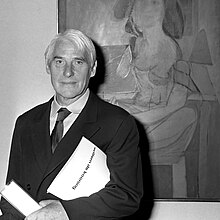Interchange, also known as Interchanged, is a 1955 abstract expressionist oil painting on canvas by Dutch-American painter Willem de Kooning (1904–1997). Like Jackson Pollock, de Kooning was one of the early artists of the abstract expressionism movement, the first American modern art movement. The painting measures 200.7 by 175.3 centimetres (79.0 by 69.0 in) and was completed in 1955. It marked the transition of the subjects of de Kooning's paintings from women to abstract urban landscapes. It reflects a transition in de Kooning's painting technique due the influence of artist Franz Kline, who inspired de Kooning to paint with quickly made gestural marks as opposed to violent brush strokes. The painting features a fleshy pink mass at its center, representing a seated woman.[1]
| Interchange | |
|---|---|
 | |
| Artist | Willem de Kooning |
| Year | 1955 |
| Medium | Oil paint on canvas |
| Dimensions | 200.7 cm × 175.3 cm (79.0 in × 69.0 in) |
| Location | Private collection of Kenneth C. Griffin |

Originally sold by the artist in 1955 for $4,000, it was sold by the David Geffen Foundation to Kenneth C. Griffin for $300 million in September 2015, then ranking it first on the list of most expensive paintings.[2][3][4] It was later on loan at the Art Institute of Chicago,[5] but by 2024 was no longer there. It is now ranked second on the list of most expensive paintings, only surpassed by Leonardo da Vinci’s Salvator Mundi, which sold for $450.3 million in November 2017.
Background
editInterchange was completed in 1955. de Kooning had concentrated much of the early part of the 1950s reworking abstract figure study works of the female figure which he started in 1948. These were associated with his solo exhibition in 1953 which was called Paintings on the Theme of the Woman which opened in New York City that year.[6] Some of the titles for these works were associated with various states of Woman I, Woman III and Woman, as well as Two Standing Women. By 1955, de Kooning had moved away from painting the human form and continued with the abstract rendering of the architecture and communities of his surroundings in New York City. Some of de Kooning's 1955 oil paintings prominent at that time were Police Gazette, Composition, Gotham News, Saturday Night, and Easter Monday.
Name of the painting
editDe Kooning's preferences for the selection of names for his oil paintings appeared to correspond to references to the neighborhood where he was living at that time in New York City, for example, Interchange.[6]
Ownership history
editDe Kooning sold the painting in the Sidney Janis Gallery shortly after it was completed for $4,000 to architect Edgar Kaufmann Jr., whose father Edgar J. Kaufmann owned Kaufmann's department store in Pittsburgh.[7] Kauffman's estate sold the painting, alongside other pieces of his art collection, at Sotheby's in New York in November 1989, during the Japanese asset price bubble, to Japanese art dealer Shigeki Kameyama, owner of the Mountain Tortoise Gallery in Tokyo, for $20.7 million, setting a then-record price for a living artist.[7][8] The sale occurred 3 months after a judge declared de Kooning to be mentally incompetent due to Alzheimer's disease.[9]
The painting was sold a few years later to David Geffen, at a loss due to the bursting of the Japanese asset price bubble and the early 1990s recession.[10][11]
In September 2015, Geffen sold Interchange for $300 million to hedge fund manager and billionaire Kenneth C. Griffin. Griffin paid $500 million for two artworks, including $200 million for Jackson Pollock's Number 17A.[12][5][13]
References
edit- ^ Barnes, Bart (March 20, 1997). "ABSTRACT EXPRESSIONIST WILLEM DE KOONING DIES". The Washington Post. Archived from the original on August 28, 2017. Retrieved June 19, 2022.
- ^ Smith, Aaron (February 19, 2016). "Ken Griffin buys two paintings from David Geffen for $500 million". CNN. Archived from the original on May 11, 2022. Retrieved June 19, 2022.
- ^ Frank, Robert (February 18, 2016). "Griffin spent $500M on two paintings: Sources". CNBC. Archived from the original on August 16, 2016. Retrieved September 9, 2017.
- ^ Embuscado, Rain (February 18, 2016). "Ken Griffin Spends $500 Million on Two Paintings". Artnet. Archived from the original on February 20, 2016. Retrieved February 25, 2016.
- ^ a b Johnston, Chris (February 18, 2016). "Private sale believed to be one of contemporary artwork's largest ever". The Guardian. ISSN 0261-3077. Archived from the original on November 20, 2016. Retrieved December 11, 2016.
- ^ a b Prather, Marla; Sylvester, David; Shiff, Richard (1994). William de Kooning: Paintings. Washington, D.C.: National Gallery of Art. p. 127. Archived from the original on 2021-04-18. Retrieved 2022-06-19.
- ^ a b Tully, Judd (November 9, 1989). "Auction". The Washington Post. Archived from the original on August 27, 2017. Retrieved June 19, 2022.
- ^ Bumiller, Elisabeth (December 11, 1989). "THE TYCOONS OF JAPAN'S GREAT ART TAKEOVER". The Washington Post. Archived from the original on August 27, 2017. Retrieved June 19, 2022.
- ^ THOMAS, KELLY DEVINE (September 8, 2011). "Shaping de Kooning's Legacy". ARTnews. Archived from the original on May 16, 2021. Retrieved June 19, 2022.
- ^ Crow, Kelly (February 25, 2016). "Billionaire Ken Griffin Paid $500 Million for Pollock, De Kooning Paintings". The Wall Street Journal. Archived from the original on April 13, 2021. Retrieved June 19, 2022.
- ^ Reif, Rita (January 26, 1990). "Auctions". The New York Times. Archived from the original on April 18, 2021. Retrieved June 19, 2022.
- ^ "Billionaire drops $500M for 2 masterpieces". Fox News. Bloomberg News. February 19, 2016. Archived from the original on March 6, 2022. Retrieved June 19, 2022.
- ^ "Billionaire paid $500 million for abstract expressionist paintings in record art deal". The Daily Telegraph. 23 February 2016. Archived from the original on 18 May 2021. Retrieved 19 June 2022.